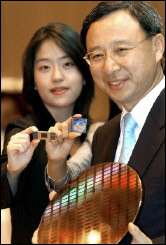Samsung unveils world's first 16-gigabit NAND flash memory chip

Samsung Electronics Co., Ltd., announced that it has developed the world's highest density NAND flash -- a 16Gigabit (Gb) NAND memory device. NAND is the most widely used memory for multi-feature mobile applications.
"Memory is opening a bold new world in consumer electronics," said Dr. Chang-Gyu Hwang, Samsung Electronics' semiconductor business president and CEO, at a press conference in Seoul today. "With cards containing multiple 16Gb flash memory chips, you will be able to take your entire music and personal video libraries with you on one small portable device."
The 16Gb NAND density was achieved with the industry's first use of 50-nanometer (nm) technology directly applicable to mass production processes and by using Samsung's proprietary 3D-transistor architecture. The finer geometry substantially reduces the noise level between cells to enable continued migration of storage platforms.
The new 16Gb memory device should accelerate further expansion of the NAND flash market across mobile and portable digital applications as an alternative to mini-HDDs (hard disk drives) and even HDDs for laptops. The development of the 16Gb NAND flash comes at an opportune time as consumer electronic (CE) manufacturers are now considering the introduction of NAND-based storage to bolster performance and power consumption levels in new CE gadgets.
Development of the 16Gb NAND flash memory makes it easier to store massive amounts of data on small portable devices. Availability of Samsung's 16Gb NAND will allow mobile and portable application designers to use memory cards with densities up to 32-Gigabytes (GBs) by combining up to 16 such devices on a single card. A 32GB density translates into the ability to store either 200 years of an average daily newspaper, 8000 MP3 music files (680 hours) or 20 DVD resolution movies (32 hours of high resolution video footage) on a mobile device.
The cell size of Samsung's new fingernail-sized flash has been reduced 25% from that of the 8Gb NAND memory developed last year using 60-nanometer technology. The new flash memory boasts the industry's smallest cell size -- 0.00625 square microns per bit. The 16Gb device holds 16.4 billion functional transistors, each measuring one two-thousandths the thickness of a piece of human hair.
Samsung plans to begin mass producing its 16Gb NAND flash in the second half of 2006.
This year's introduction of 16Gb NAND flash continues Samsung success in doubling memory density for each of the past six consecutive years.
The NAND flash market has enjoyed a compounded annual growth rate of 70 percent from 2001 through 2005. This year, total NAND revenues are expected to exceed that of NOR flash for the first year ever.















